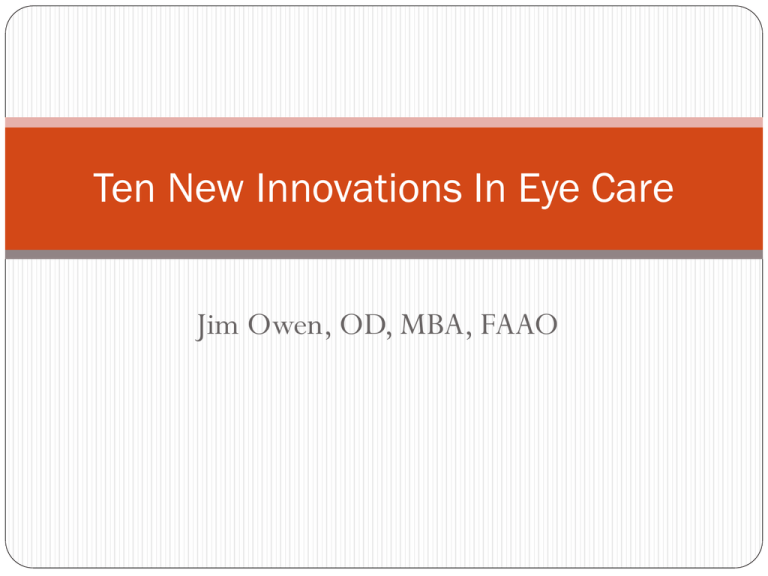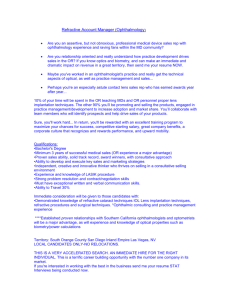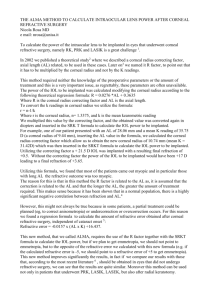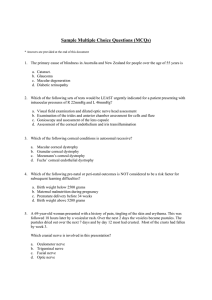Ten New Innovations In Eye Care
advertisement

Ten New Innovations In Eye Care Jim Owen, OD, MBA, FAAO First Innovation Automating Cataract Surgery Current Manual Cataract Surgery Multiple steps and multiple devices 01/04/2013 7 Limitations of Manual Cataract Surgery Visual Outcomes • Distance Correction Predictability Far less than that of LASIK Astigmatism Correction Effective Power of IOL Limits Presbyopia Correction Safety • Complications > LASIK Surgeon Confidence • Critical for Widespread Adoption Common Posterior Capsular Opacification Cystoid Macular Edema (transient) Vitreous Loss Corneal Endothelial Cell Loss Incidence 10-30% 2-10% 1-5% 4-10% Vision Threatening Retinal Detachment Cystoid Macular Edema (persistent) IOL Malposition Need for Corneal Transplant Endopthalmitis Incidence 0.6-1.7 % 1-2% 0.3% 0.3% 0.1% 01/04/2013 8 Manual Cataract Surgery Corneal Incisions Capsulotomy Lens Removal IOL Implantation 9 VIDEO 01/04/2013 Pre-Production Model Complete & In Clinical Use • Live Video • OCT • Procedure Templates • Touch Screen • Data Entry • Ergonomic • Space saving design 01/04/2013 10 Intuitive Software Control Delivers Image-Guided Surgery Procedure Precision & Integration 01/04/2013 11 Technology Summary 2 systems in clinical use ◦ Europe and USA >500 cases, fully sighted eyes, lens, capsule and cornea Image-Guided Laser Cataract Surgery Micron Level Precision and Reproducibility Key Steps Performed in Low Stress “Closed Eye” Unparalleled Procedure Flexibility and Innovation 1 3 LenSx Lasers, Inc. 01/04/2013 Image-Guided Laser Cataract Surgery Chop Video? Liquefaction Video? The lens liquefaction and fragmentation is not available for sale in the United States 1 4 LenSx Lasers, Inc. 01/04/2013 Goals of Laser Cataract Surgery Improve Every Procedure, Technology and Surgeon • Presbyopia, Astigmatism & Monofocal • Refractive Precision and Integration Key Step Corneal Incision Current Surgery Refractive Impact Underutilized Astigmatism Not Optimized Capsulorhexis Variable Sized, Variable IOL Position & Not Centered Effective Lens Power Lens Fragmentation Excessive Ultrasound Power Delayed recovery New laser-based standard, synonymous withvisual patient pay Safety Impact Infection Capsular Tears, Posterior Capsule Opacification Loss of endothelial cells, Capsule Rupture LenSx Lasers, Inc. 01/04/2013 15 Visibility to Better Medicine 100 Percent of Sample (%) 90 80 70 60 50 40 30 20 10 0 Diameter Error (mm) Laser (n=60) Manual (n=60) Two fold reduction in IOL position variability Major opportunity for improvement in refractive correction 01/04/2013 16 2 Weeks PostOp OCT Conclusions Femtosecond laser applications in liquefaction was safe, effective and efficient Capsulotomy size, shape and reproducibility was statistically improved over manual techniques Corneal incisions were reproducible and had precise dimensions and geometry A refractive capsulotomy (perfect shape, size, centration), liquefied lens removal with simple I/A, plus the precision of laser-created corneal incisions may enable surgeons to design and deliver an entirely new level of refractive cataract surgery. Second Innovation Replacing Our Natural Lens Synchrony Dual Optic IOL Single-piece, silicone IOL 5.5 mm high plus anterior optic (+32 D) 6.0 mm variable negative posterior optic Optics connected by spring haptics • Size 9.5 mm x 9.8 mm • Theoretical accommodation 3.5 D with 1.5 mm of anterior lens movement Binocular Uncorrected Distance & Near Visual Acuity 1 Year Post-op n=124 3 Years Post-op n=50 Distance Distance 100% 90% 80% 70% 60% 50% 40% 30% 20% 10% 0% 98% 92% Near 93.5% 98% 98.4% 72.6% 100% 90% 80% 70% 60% 50% 40% 30% 20% 10% 0% 20/32 or Better 20/40 or Better 98% 97% 92% 98% 86% 72% 20/25 or Better 20/25 or Better Near 20/32 or Better 20/40 or Better Synchrony Video Synchrony dual-optic accommodating intraocular lens Part 2: Pilot clinical evaluation Enrolled patients older than 40 with visual significant cataracts and less than 2.00 D of corneal cylinder 26 Eyes of 21 Patients 67% Female All Hispanic Results - Distance No loss of BCVA in all eyes Mean SE -0.52 (+/- 0.77D) 50 % within +/- (0.50) 79.4% 20/40 or better Results - Near 95.8 % J3 or Better Minimal add to J1 +0.75 All stable at 1 and 2 years Methods: Subjective Testing Subjective tests performed at the 2 year visit Distance-corrected near VA Push Down accommodative amplitude Defocus curve (-3.0 D to +1.5D in 0.5 D steps) Tests repeated at the 3 year visit Distance-corrected near VA Push Down accommodative amplitude All subjective tests performed with distance correction in place. Results: Subjective Testing Visual Acuity (logMAR) 0.60 20/ 80 0.50 20/ 63 0.40 20/ 50 0.30 20/ 40 0.20 20/ 32 0.10 20/ 25 0.00 20/ 20 n = 5 eyes -4 -3 -2 -1 0 Lens Power (D) 1 2 Snellen Visual Acuity Defocus curve confirms Push Down amplitude of accommodation Bilateral Synchrony logRAD BCDVA Reading Acuity @ 1 and 2 years 0.5 0.4 0.3 0.2 0.1 0 -0.1 -0.2 20/28 20/23 1 Year N = 19 patients 2 Years Reading Acuity Mean Reading Acuity at 1 year was 0.15 logRAD (SD 0.13), and at the 2 year follow-up improved to 0.07 logRAD (SD 0.11). This difference was found to be statistically significant (p< 0.01). VICTOR BOHORQUEZ, MD., ASCRS 2009 Bilateral Synchrony ReadingSynchrony SpeedReading @ 1Speed and 2 years 300 250 WPM 200 150 100 50 0 1 0.9 N = 19 patients 0.8 0.7 0.6 0.5 0.4 0.3 0.2 0.1 0 logRAD 1 Year 2 Years Higher (better) scores were seen at smaller font sizes (0.3 and below) at the 2 year follow-up. This difference was statistically significant (p<0.001) VICTOR BOHORQUEZ, MD, ASCRS 2009 Long Term Objective Evidence of Accommodation of the Synchrony Dual Optic IOL David Chang, M.D., Ricardo Alarcon, M.D. , Victor Bohorquez, M.D, ASCRS 2010 Methods: Objective Testing 5 eyes with demonstrated UBM accommodation at 1 year were evaluated at 2 and 3 years with iTrace wavefront aberrometer UBM @ 1 year iTrace @ 2 & 3 years Methods: Objective Testing UBM Front and back optic position were compared between cycloplegic and near states iTrace Measurements were performed for a 3 mm pupil Average of 3 measurements at cycloplegic and near states were obtained for each patient Refractive maps of the average measurements were created Synchrony vs. ReSTOR Randomized Double-masked Multicenter Clinical Study Study Design Randomly assigned to receive binocular Synchrony or ReSTOR 50 subjects (100 eyes) in each arm Patient and technician are masked Ivan Ossma, MD, MPH, Victor Bohorquez, MD, Ricardo Alarcon, MD, Andrea Galvis, MD, ASCRS 2009 Contrast Sensitivity 1 Year Results Photopic 1.50 1.25 1.00 0.75 0.50 0.25 0.00 Synchrony Restor 1.5 3 2.00 Log Contrast Sensitivity Photopic With Glare 1.75 Sensitivity Log Contrast Sensitivity 2.00 Mesopic Synchrony Restor 1.75 1.50 1.25 1.00 0.75 0.50 0.25 Mesopic With Glare 6 12 18 Spatial Frequency (cycles/degree) Synchrony (N = 37) 0.00 1.5 3 6 12 18 Spatial Frequency (cycles/degree) ReSTOR (N = 34) Significantly better contrast sensitivity in patients implanted with Synchrony in mesopic & photopic conditions Synchrony vs. ReSTOR Halos at 1 Year 50 % of subjects with Halo 45 Synchrony 40 35 ReSTOR 30 25 20 15 10 5 0 Moderate Synchrony (N = 39) Severe/very severe ReSTOR (N = 45) Significantly lower rates of Halos with Synchrony vs. ReSTOR at 1 year Nu Lens Purpose To evaluate the accommodative range of the NuLens AIOL in 5 patients and to study its behavior and biomechanics in 5 eyes Implanted by one experience surgeon (L. Izquierdo) at Oftalmosalud Eye Institute Lima-Peru. Material and Methods Material and Methods: 5 eyes of patients range between 27 and 65 years old, 4 women and 1 men, No corneal pathology who had impaired vision in one eye due to amblyopia (4 high myops and 1 cataract patient). Results Pre-Implantation values: sphere -5.60 cylinder -2.55, LogMar BCVA (media 0.6520) Near VA at 40cm (media 12.25). Post-Implantation values: sphere -0.45 cylinder -2.50 LogMar BCVA (0.7380) near VA at 40cm (media 14.50). Accommodative range: 6.00 Diopters. p=0.0000 (See Table). Zonule implatation of the haptic of the NULENS AIOL Conclusions This is a new technology which seems to be an alternative in the future to achieve more accommodative range and therefore a better quality of vision. We are still working in adjusting the power of the AIOL and its size to improve its biomechanics inside of the eye. NuLens demonstrated to have an accommodative range of 6 Diopters in all patients studied so far and a central positioning without damaging any anterior and posterior chamber structures of the eye. Third Innovation Can You Do That on the Cornea Intracor Procedure Video INTRACOR Presbyopia Cavitation gas in ring cuts 4 days preop 4 days preop Mike P. Holzer, MD 1 hour postop 1 hour postop Gas escaped from cornea 1 day postop 1 week postop Evaluation Study Design 132 eyes – 6 months follow up Average age 52.8 (44-67) Bilateral Procedure Results Distance Corrected Near Vision Pre-op average J8 3 months average J2 Uncorrected Near Vision 97.6% J3 or better Uncorrected Distance and Near 93.75% J3 and 20/25 Results Wavefront Data Pre-op HO RMS 0.24 Post-op HO RMS 0.21 Spherical Abberation Pre-op 0.080 Post-op -0.065 No change in Pachymetry, Hysteresis, Endothelial Cell Count Summary: INTRACOR High potential for correction of presbyopia • Non invasive very low risk for infections Stable refractive outcome during follow up period Significant gain in uncorrected near visual acuity Slight central steepening and negative q-value • No weakening of cornea • Future treatments: low myopia / hyperopia / astigmatism, retreatments of remaining refractive errors following IOL- or Excimer Laser Surgery Mike P. Holzer, MD FORTH INNOVATION Computer Based Cortical Vision Training Company History HISTORY OF REVITALVISION Originally developed in Israel in 1999. US FDA 510(K) approval given in August 2001 for the treatment of amblyopia. Relocated to Singapore in 2004 under the company name NeuroVision, Inc. due to government interest in the treatment of pediatric myopia in the Asian Pacific Region. Purchased by RevitalVision LLC in 2009 and operations were relocated to Lawrence, Kansas. 01/04/2013 01/04/2013 12.10. 09 52 52 www.revitalvision.com Clinical Concept VISION = EYE Vision aids like Spectacles and contact lenses + BRAIN RevitalVision RevitalVision optimizes cortical visual processing Neurologically trains the brain to see better 01/04/2013 01/04/2013 12.10.2009 12.10. 09 53 53 www.revitalvision.com PRESENT PRODUCT OFFERINGS OTHER PRODUCTS ON THE MARKET: Sports Vision, Night Driving, Low Myopia, Amblyopia 01/04/2013 01/04/2013 12.10. 09 54 54 www.revitalvision.com CLINICAL IMPLEMENTATION TREATMENT FLOW Step 1: ECP VA data creates baseline for RevitalVision treatment Step 2: Step 3: Step 4: Patient completes two sessions; neural performance analyzed Twenty customized sessions completed at home via internet; darkened room Treatment completed. Vision performance maximized Results sent to server. Sessions adjust to progress, improving neural performance 01/04/2013 01/04/2013 12.10. 09 55 55 www.revitalvision.com SCIENTIFIC BUILDING BLOCKS Neuronal lateral interactions Gabor patch visual stimulus Use of flankers Perceptual learning Brain plasticity 01/04/2013 01/04/2013 12.10. 09 56 56 www.revitalvision.com GABOR PATCH Gabor Patches developed by Nobel Prize winning physicist, Dennis Gabor Widely used in the field of visual neuroscience to describe the shape of receptive fields of neurons in the primary visual cortex Represent the most effective stimulus target for the primary visual cortex USE OF FLANKERS First Display Second Display Target Flankers The software measures the contrast threshold of a Gabor target with the presence of flankers The patient is exposed to two short displays in succession and the patient identifies which display contains three Gabors Clinical Research Summary Polat U, Naim TM, Belkin M, Sagi D. PSNA 2004;101:17:66926697. Studied 54 adult amblyopic patients who were randomized to amblyopic cortical vision training or a placebo vision-training program. Pretreatment visual acuity improved by 2.5 lines to 20/30 in the cortical training treatment group, with no improvement in the control group. The cortical vision training group experienced a commensurate increase in CSF to within the normal range. These improvements in acuity and CSF were sustained after 12 months. NeuroLASIK Durrie, D. Slade, S. Waring IV, G. 2008 Unpublished data Prospective, controlled comparison of cortical training after LASIK to sham treatment after LASIK Postoperative 3 Months N=98 UCDVA Improvement Contrast Sensitivity Improvement All Patients Worse than 20/20 postoperative NeuroLASIK Control Video Game NeuroLASIK Control Video Game 0.80 lines 0.28 lines 1.56 lines 0.34 lines 79% 52% 90% 47% NeuroLASIK UCDVA Improvement 2.5 2 2 No. of Lines1.5 0.9 1 0.5 0.45 0.4 Eyes Worse than 20/20 All Eyes 0 Eyes Worse than 20/20 All Eyes Treatment Group Control Group Suggests a cortical limit to how much a patient may improve. NeuroLASIK Subjective Improvement after NeuroLASIK A Moderate Amount Reading Road Signs Watching TV, Movies Day Time Driving Night Time Driving Sports Recognizing Faces Using Computer A Little Not at All NeuroLASIK Control Reading Books CLINICAL RESEARCH SUMMARY Hunkeler J, Lindstrom D. Unpublished Data 2009 Prospectively evaluated cortical training after IOL implantation in 60 eyes. IOLs included aspheric monofocal, multifocal and accommodative (5 IOL styles total) Improvement in UCDVA and UCNVA for the entire group was 1.3 and 1.0 lines respectively Mean improvement in distance and near CSF were 223% and 197% respectively. STUDY RESULTS: IOLs* No. of Eyes Distance VA Near VA Distance CSF Near CSF Improvement Improvement Improvement Improvement Rezoom 24 1.5 Lines 0.6 Lines 157% 160% Restor 6 1.6 Lines 1.2 Lines 135% 143% Crystalens 6 0 Lines** 1.8 Lines 370% 227% Alcon Monofocal 10 1.3 Lines 0.6 Lines 250% 238% AMO Monofocal 10 1.3 Lines 1.7 Lines 354% 263% Total 56 1.3 Lines 0.9 Lines 223% 197% Average Age - 70 years old *Standard and premium lenses ** Patients Baseline VA 20/15 – No room to improve STUDY RESULTS: CONTRAST SENSITIVITY UCVA=20/44 Before UCVA=20/25 After Spatial Frequency SUMMARY Novel approach to improvement in visual function “Physical therapy for vision” Computer based primary cortex vision training Founded on proprietary cortical visual science therapeutic strategies Average improvement of 2 lines visual acuity and 100% in contrast sensitivity Non-invasive and safe Multiple product offerings including post IOL implant therapy, post refractive surgery, presbyopia Future product offerings in development FIFTH INNOVATION Quantifying Dry Eye Osmolarity in the Diagnosis of Dry Eye Disease Clinical Test PPV Osmolarity 87% Schirmers 31% TBUT 25% Staining 31% Meniscus Height 33% Osmolarity is the “gold standard” test for Dry Eye Disease 45 years peer reviewed research Osmolarity has been added to definition of Dry Eye Global marker of Dry Eye, indicating a concentrated tear film Source: DEWS Report, Ocular Surface April 2007 Vol 5 No 2, & Tomlinson A, et. al., IOVS 47(10) 2006 Clinical Evaluation of Osmolarity Standard osmometers require 10 µL Dry eye patients have less than 1/200th of that volume available Traditionally rely on glass capillaries to collect tears Collection can cause reflex tearing Fluid can evaporate during transfer Older instruments require half an hour to get one reading As a result, tear film osmometry was confined to the laboratory Advanced Instruments Tear Osmometer TearLab Precision @ 50 nL < 2% coefficient of variation @ 50 nanoliters Glucose ≥ 5.0% CV @ 5 microliters (5,000 nL) Cholesterol > 4.0% CV @ 20 microliters 20 µL 5 µL 50 nL Safe, simple collection No reports of corneal or conjunctival trauma in 468 eyes [TearLab™ FDA 510(k) submission] Winner 2009 MDEA for In Vitro Diagnostics Source: Kimberly MM et. al., Clinica Chimica Acta 364 (2006), Volles DF et. al. Pharmacotherapy 18:1 (1998)., Osmolarity Severity Analysis IOVS in press July 14, 2020 Manuscript 10.5390 Osmolarity Provides Improved Standard of Care Tear osmolarity is the most accurate diagnostic test for dry eye disease Elevated osmolarity is the central mechanism causing ocular surface damage Allows a physician to rapidly diagnose & classify patients with a global assessment In combination with a slit lamp exam, physicians can select therapies based on mechanism of disease and severity Modulate therapy using a quantitative endpoint Tomlinson A, IOVS 2006. DEWS Ocular Surf 2007 TearLab Reveals Biocompatibility of Contact Lenses Montani Giancarlo Optometrist FIACLE, Dept di Optometria, Università del Salento Osmolarity in Refractive Surgery 30 subjects were recruited for the study n = 24 dry eye, n = 6 normal Classified as dry eye if the maximum preoperative osmolarity was greater than 308 mOsms/L LASIK vision correction with the LADARVision 4000 or the WaveLight ALLEGRETTO WAVE™ Excimer Laser System Vitamin, Prednisolone 1% and lubricant drops prescribed post-op Bilateral osmolarity measurements were performed in triplicate at each visit using the TearLab Osmolarity System Measurements were made preoperatively, 14 days, and 1 month post- operatively Osmolarity in Refractive Surgery Maximum osmolarity of both Normal and DED subjects increased by 10 mOsms/L following surgery (p = 0.067) Normal: 304.0 ± 3.5 DED: – 314.5 ± 13.1 mOsms/L 329.8 ± 13.7 – 339.5 ± 24.0 mOsms/L Normal subjects had significantly lower post operative osmolarity than DED subjects (p = 0.021) Very large increases >10 mOsms/L were observed in 13 of the 30 subjects (average increase = 29.1). Tear Osmolarity in the Diagnosis of Dry Eye Disease If > 308 mOsms/L or larger than a 8 mOsms/L difference between eyes Normal subjects have a tight band of variability Patients with mild/moderate DED show variability Variability is the hallmark of this stage in which compensatory mechanisms are still operative in response to environmental stress Patients with moderate to severe DED have tear osmolarity which varies between eyes and over time but generally remains within the abnormal range Sixth Innovation The Lid Hygienist Challenges of Current MGD Therapies Therapy1 • Warm compresses • Eyelid scrubs • Manual gland expression Challenges • External heat application is inadequate2,3 • Compliance1 • Only the upper portion of the glands is treated or expressed 1. 80 2. 3. Geerling G, et al. The international workshop on meibomian gland dysfunction: report of the subcommittee on management and treatment of meibomian gland dysfunction. Invest Ophthalmol Vis Sci. 2011;52(4):1938-1978. McMonnies CW, et al. The role of heat in rubbing and massage-related corneal deformation. Cont Lens Anterior Eye. February 4, 2012. Lane SS, et al. A new system, the LipiFlow, for the treatment of meibomian gland dysfunction. Cornea. 2012;31(4):396-404. 80 Warm Compresses Are Ineffective Anterior lid is highly vascular; therefore, difficult for heat application to reach gland contents Adequate temperatures cannot be achieved by the use of external warm compresses 81 Intense Pulsed Light Therapy Flash lamp emits energy from 400 – 1300 nm Filter narrows the range to around 500 nm Hemoglobin absorbs the light energy and eliminates the blood vessels Closed vessels no longer send inflammatory mediators to the meibomian glands Liquifies “plugged” meibomian gland secreations Treatment 8-12 J/cm at 20-30 milliseconds pulse width Treat directly below the lid margin Apply sunblock Non-steroidal bid 4 days 4-6 Treatments within 30 days Results Decrease in telagiectasic vessels Increase in TBUT Improvement in quality of meibomian secretions Decrease in patient symptoms LipiFlow® Thermal Pulsation System LipiFlow safely and effectively treats Meibomian gland obstruction in both upper and lower eyelids simultaneously, in an in-office procedure, taking only 12 minutes per eye 85 85 LipiFlow® Offers a Solution for Patients With MGD In both upper and lower eyelids simultaneously Lid warmer Applies directional heat to inner eyelid Activator Applies intermittent pressure to the outer eyelid Insulated lid warmer shields eye from heat and vaults above the cornea to prevent corneal contact Heats comfortably to liquefy the Meibomian gland contents 86 Inflatable air bladder Facilitates release of secretions from the Meibomian glands Therapeutic Goal of Pulsation Lid warmer Applies directional heat to inner eyelid Activator Applies intermittent pressure to the outer eyelid Insulated lid warmer shields eye from heat and vaults above the cornea to prevent corneal contact Heats comfortably to liquefy the Meibomian gland contents During the heating phase of the treatment (as opposed to after) Increase heat transfer efficiency Inflatable air bladder Alleviate the obstruction Enable patient to experience little to no discomfort during treatment 87 LipiFlow® Provides Heat and Pressure to Liquefy and Evacuate Obstructed Glands A sterile disposable eyepiece connects to a console used by the physician to control the application of heat and pressure to the eyelids Lid warmer Composed of a heater, eye insulation, and vaulted shape Heat is applied to the palpebral surfaces of the upper and lower eyelids directly over the Meibomian glands Activator Composed of an inflatable air bladder and a rigid activator Graded pulsatile pressure is delivered to the outer eyelid 88 Complete Gland Expression Obstructed glands should be monitored for gland atrophy LipiFlow® offers relief through evacuation of gland contents The LipiFlow treatment provides improved quality and quantity of gland secretions 89 Safety • The globe is insulated/protected from heat during treatment1 • Massaging pressure is not transferred directly onto the eyeball1 • Pressure required is significantly less compared with unheated manual expression2 90 1. Friedland BR, Fleming CP, Blackie CA, Korb DR. A novel thermodynamic treatment for meibomian gland dysfunction. Curr Eye Res. 2011;36(2):79-87. 2. Korb DR, Blackie CA. Meibomian gland therapeutic expression: quantifying the applied pressure and the limitation of resulting pain. Eye Contact Lens. 2011;37(5):298-301. AcuFocusTM KAMRA Corneal Inlay Overall diameter: 3.8 mm Designed to improve near vision in patients with Presbyopia Easily implanted Minimal impact on distance vision Removable Central aperture:1.6 mm AcuFocus™ KAMRA How it Works The small aperture created by the AcuFocus™ ACI 7000 blocks the unfocused light on the retina Blocks unfocused light Allows focused light into the eye Inlay Design Thickness: 5µ Weighs less than a salt crystal Curvature: 7.5 mm radius 1.6mm Ø 8,400 holes (5-11µ) 3.8mm overall diameter Corneal Health Variable Hole Size Pseudo-random Pattern Controlled Hole Density Solid Edges The AcuFocus™ KAMRA Procedure Topical anesthetic eye drops Flap created The AcuFocus™ ACI 7000 is inserted and centered The flap is closed Takes less than 30 minutes - start to finish Depth of Focus Simulation f/5.6 simulates human eye ~ 4.0 mm pupil f/22 Simulates the effect of the Inlay ~ 1.6 mm pupil 8th Innovation Annidis - Multi-spectral Digital Ophthalmoscope RHA ™ Optometrist’s Gateway to the RPE FDA approved Health Canada approved European CE Mark obtained ANNIDIS HEALTH SYSTEMS 101 Conventional vs. Multi-Spectral Fundus Camera Range Xenon Flash Spectral Slicing PID 79 - Optos Composite PID 79 - Optos Green PID 79 - Optos Red PID 79 – RHA, 109 PID 79 – OCT, Macular Hole 110 PID 144 – Fundus Photo 111 PID 144 – RHA, AMD 112 Ninth Innovation A New Age in Refraction Surpassing Yester-decade’s Refraction Technology PSF Refractor Classical Phoropter Subjectivity is the Key to Reliability • Vmax PSF refraction reliability is maximized where the optics of the eye, retina and the brain are working together • Since it is refracting using PSF, higher order aberrations are eliminated as well. • Patient Vision is thereby, maximized PSF Refraction is More Sensitive Changes in 0.05D are now noticeable Easier than Snellen Letter Chart Your Acuity Test Vmax PSF Refractor- a Phoropter “Extreme Makeover” Increase sensitivity of measurement- 5x Easier for Patient, moves quicker to the end point Ergonomic, no strains and no aches Connectivity to EMR, error-free operation Positioning- Differentiate your practice!! Clinical Test Results Eight clinical test sites in the US Over 800 patient data points Male/ female: 49% : 51% Age range: 5 to 92 Tested over 9 months OS Results of Clinical Trials OD Results of Clinical Trials Overall Patient Response Encepsion Lenses Options Designs: Hard, Intermediate, and Soft Corridor: from 11mm to 18mm Pantoscopic, Vertex Distance, Seg Height, PD Materials: All Standard, 1.60, 1.67, 1.74, Trivex Transition, Polarized Lens Coating: Premium Only with 2 Yr warranty (Reflection Free, AR, Super Hydrophobic, Extra Tough Thermal Cure) Sport, Sun Tenth Innovation There is an “App” for That IPad www.ipadfordoctors.com www.mobilehealthnews.com Fits in a white coat Allows point of care display Battery last a full clinic day Current Trends 46 % of physicians plan on purchasing an ipad in 2012 32% of physicians currently use an ipad 58% of those with ipads use them in their clinic Cool Apps EyeXM Eye Exam Pro Islet for Diabetes Pollen Count Questions





